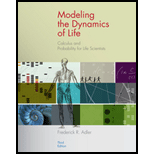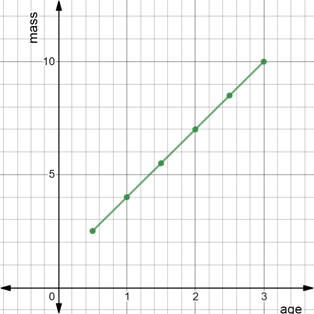
Concept explainers
To graph: The mass as a function of age from the data provided between measurement of a growing plant. Also evaluate the equation of line in both point-slope and slope intercept form and mass on day
Explanation of Solution
Given information:
The table that provides relation between measurement of a growing plant.
Graph:
Consider the table that provides relation between measurement of a growing plant.
To graph the mass as a function of age, on the horizontal axis that is x- axis, plot the age and on vertical axis that is y -axis plot the mass.
Now plot the points

Interpretation:
The point slope form of a line is
The slope-intercept form of a line is
The slope is
Here independent variable is x and dependent variable is y.
According to the question, mass Mis dependent variable and ageais independent variable.
Slope of the line is evaluate when first two points are considered that is,
Slope of the line is 3.
Equation of line in point slope form is, consider
Therefore, the equation in point-slope form is
Intercept on y -axis is 1 when compared with the equation in slope-intercept form
The above statement is interpreted as mass of the seed when age is 0 years is
Biologically this could be the mass of a new seedling.
Next, mass of seed on day
Therefore, mass is
Thus, equation in slope-intercept and point-slope formis
Want to see more full solutions like this?
Chapter 1 Solutions
Modeling the Dynamics of Life: Calculus and Probability for Life Scientists
 Algebra: Structure And Method, Book 1AlgebraISBN:9780395977224Author:Richard G. Brown, Mary P. Dolciani, Robert H. Sorgenfrey, William L. ColePublisher:McDougal LittellAlgebra & Trigonometry with Analytic GeometryAlgebraISBN:9781133382119Author:SwokowskiPublisher:Cengage
Algebra: Structure And Method, Book 1AlgebraISBN:9780395977224Author:Richard G. Brown, Mary P. Dolciani, Robert H. Sorgenfrey, William L. ColePublisher:McDougal LittellAlgebra & Trigonometry with Analytic GeometryAlgebraISBN:9781133382119Author:SwokowskiPublisher:Cengage College AlgebraAlgebraISBN:9781305115545Author:James Stewart, Lothar Redlin, Saleem WatsonPublisher:Cengage Learning
College AlgebraAlgebraISBN:9781305115545Author:James Stewart, Lothar Redlin, Saleem WatsonPublisher:Cengage Learning Algebra and Trigonometry (MindTap Course List)AlgebraISBN:9781305071742Author:James Stewart, Lothar Redlin, Saleem WatsonPublisher:Cengage Learning
Algebra and Trigonometry (MindTap Course List)AlgebraISBN:9781305071742Author:James Stewart, Lothar Redlin, Saleem WatsonPublisher:Cengage Learning Functions and Change: A Modeling Approach to Coll...AlgebraISBN:9781337111348Author:Bruce Crauder, Benny Evans, Alan NoellPublisher:Cengage Learning
Functions and Change: A Modeling Approach to Coll...AlgebraISBN:9781337111348Author:Bruce Crauder, Benny Evans, Alan NoellPublisher:Cengage Learning Trigonometry (MindTap Course List)TrigonometryISBN:9781337278461Author:Ron LarsonPublisher:Cengage Learning
Trigonometry (MindTap Course List)TrigonometryISBN:9781337278461Author:Ron LarsonPublisher:Cengage Learning





